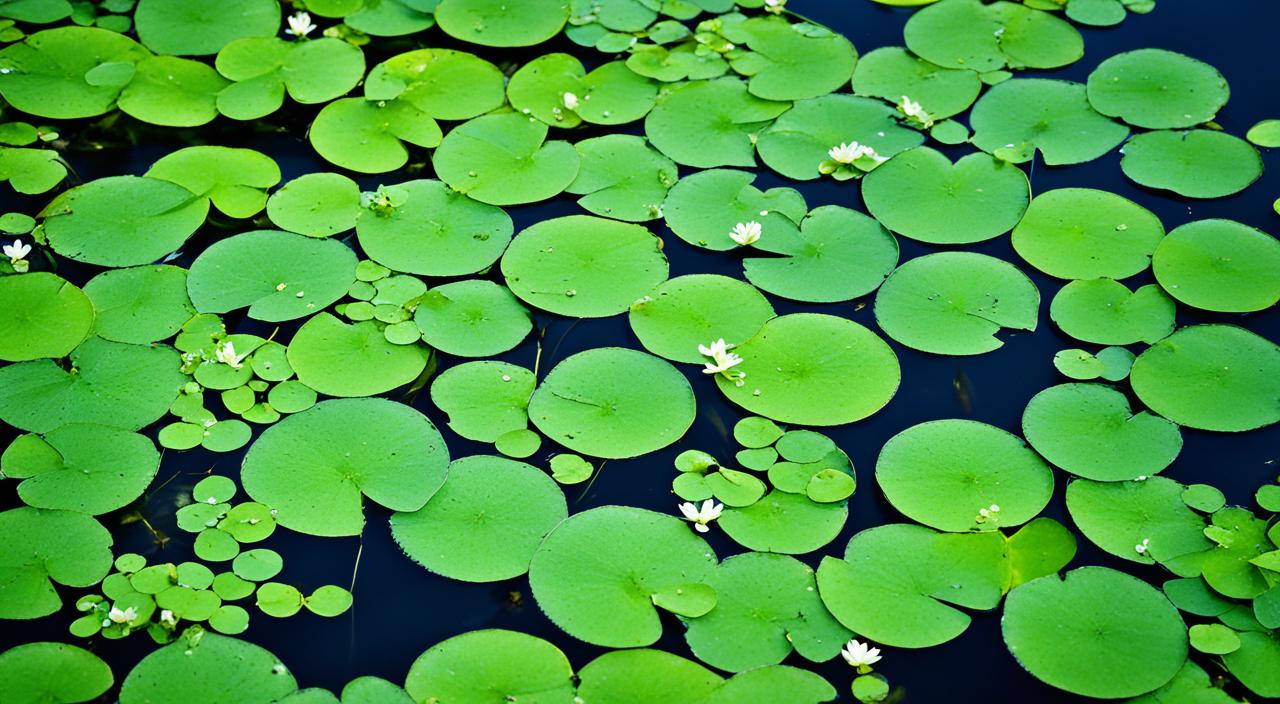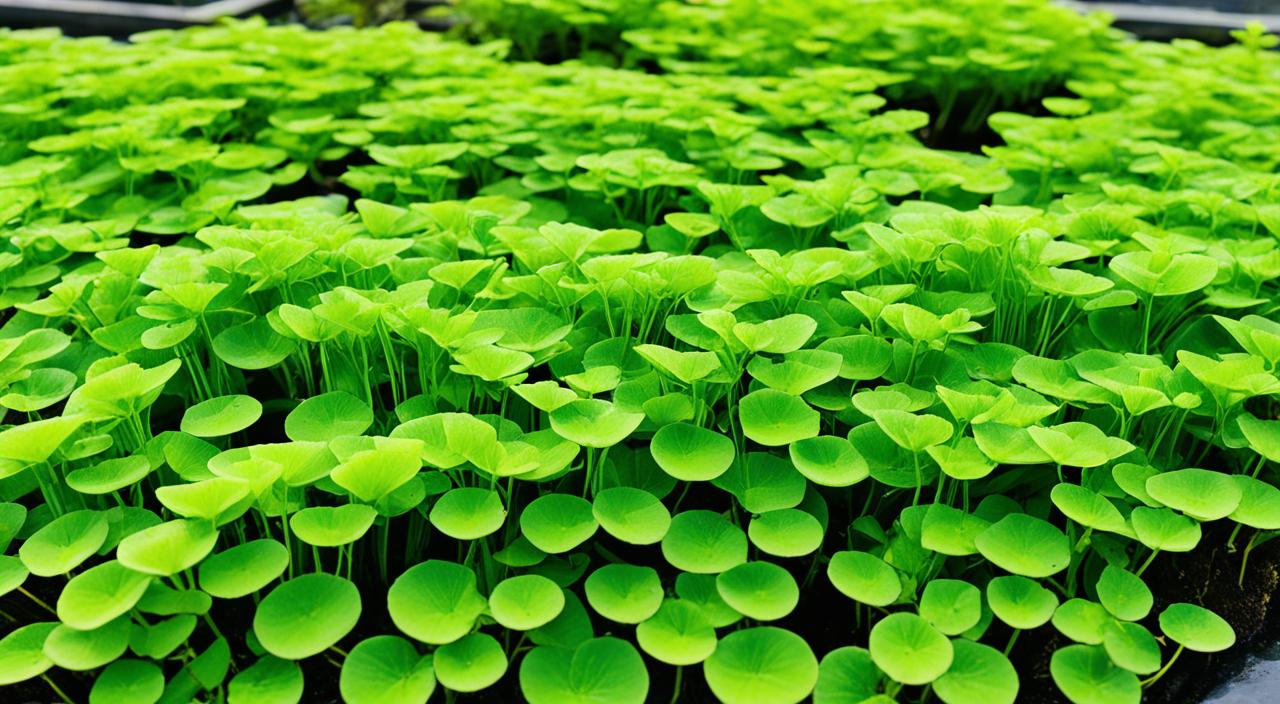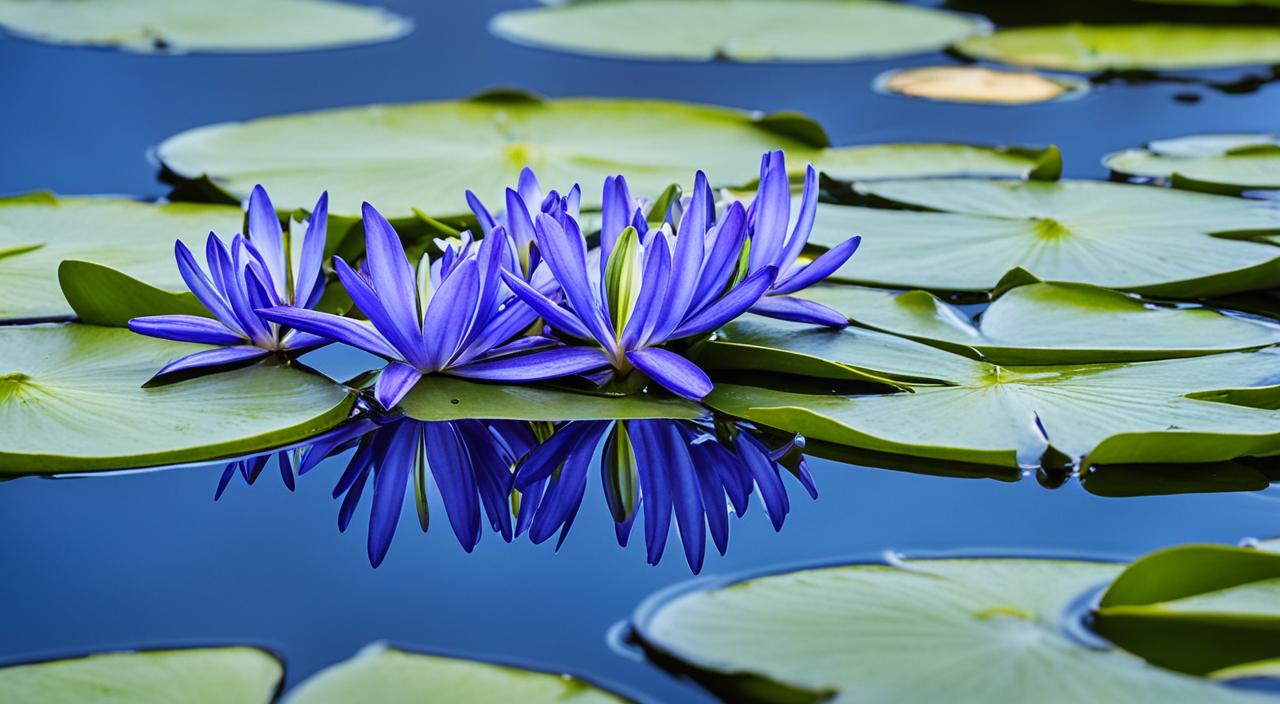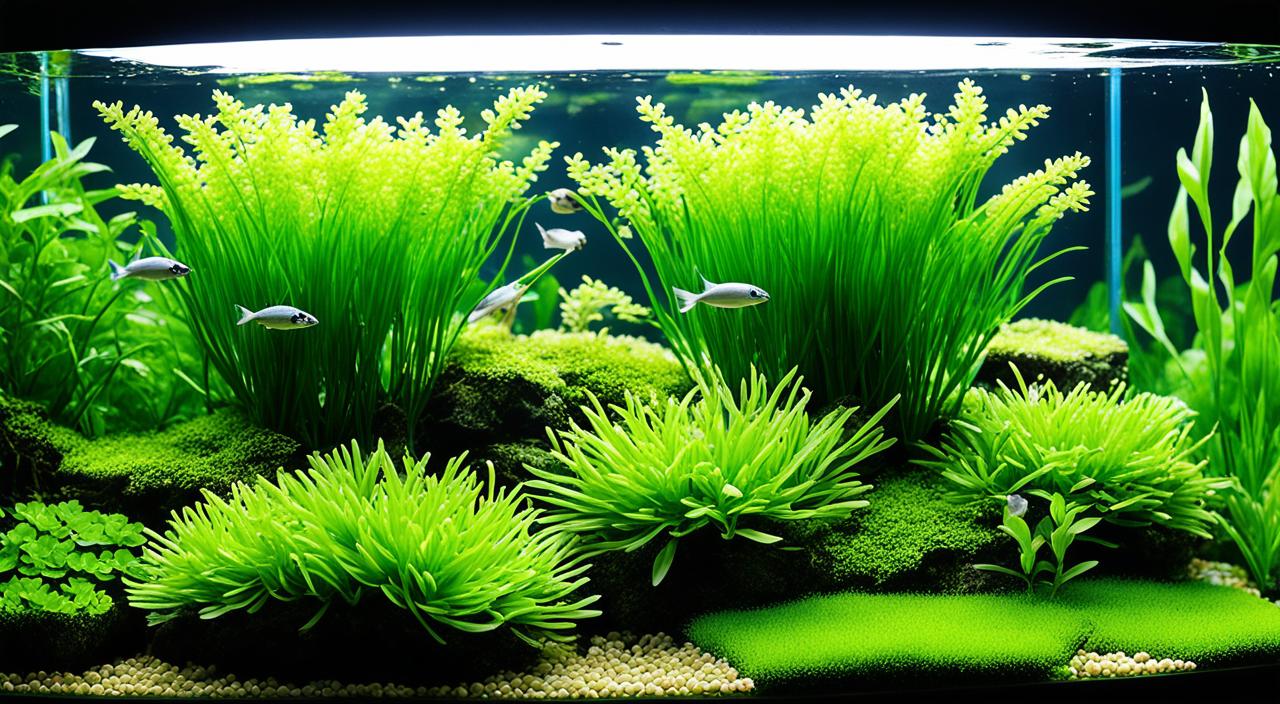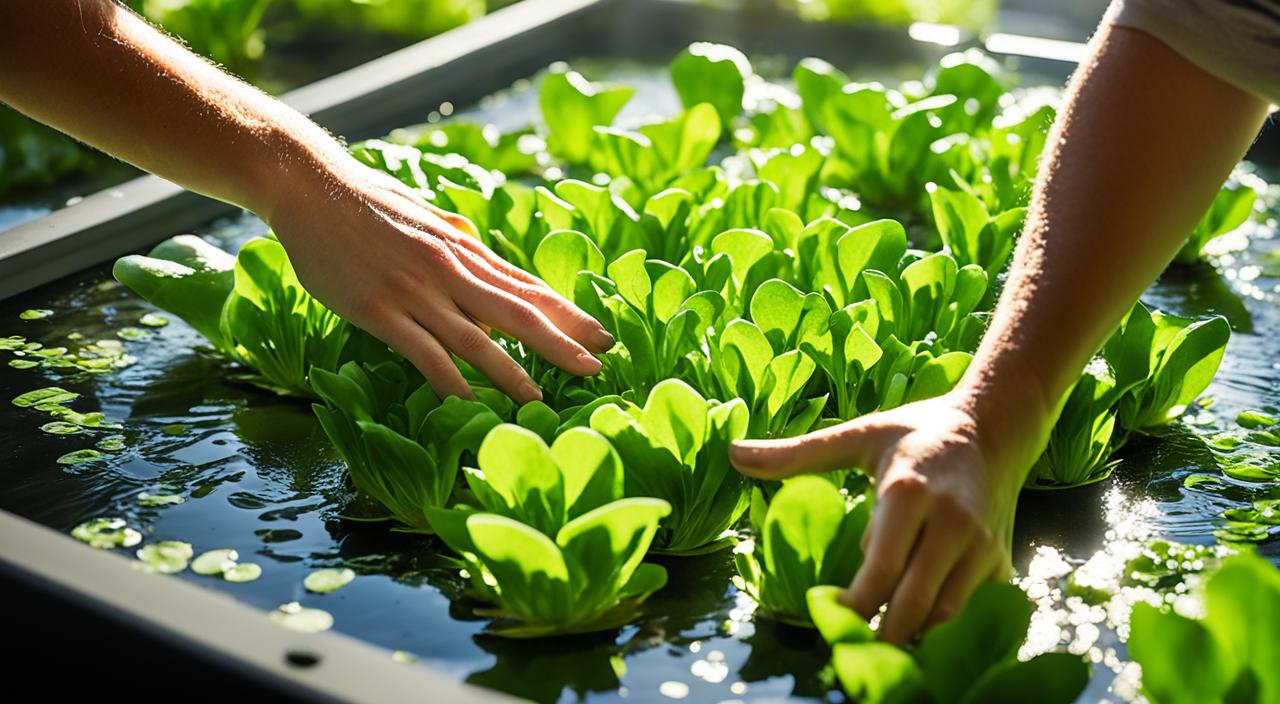Welcome to my Frogbit care guide! In this article, I will share valuable information on caring for Frogbit (Limnobium laevigatum), a famous floating aquatic plant commonly used in aquariums and aquascapes. From its origins to maintenance requirements, you’ll discover everything you need to know to keep this surface-cover plant thriving in your freshwater aquarium. So, let’s dive in!
Key Takeaways:
- Frogbit (Limnobium laevigatum) is a floating aquatic plant that adds a touch of greenery to your tank’s water surface.
- It is native to Central and South America and is widely used in aquariums and aquascapes worldwide.
- Frogbit reproduces sexually through flower pollination and seed production, as well as vegetatively, through the fragmentation of stolon segments.
- To maintain Frogbit’s vibrant appearance, provide medium to high lighting and avoid submerging the leaves.
- Frogbit is a natural water filtration plant and can create a lush water surface in your aquarium.
Brief Overview Of Frogbit (Limnobium laevigatum)
Frogbit (Limnobium laevigatum) is a popular floating aquatic plant commonly used in aquariums and aquascapes. It is known for its round or circular leaves and long, fuzzy roots. Frogbit naturally floats on the water surface and adds a touch of greenery to the tank. It is easy to care for and does not require any special attention. Frogbit can provide shade to intense lighting and offers fish and other aquatic animals a spawning refuge. It is an excellent addition to any aquarium habitat and can create a visually appealing water surface.
Frogbit (Limnobium laevigatum) brings a captivating presence to any aquarium with its circular leaves and delicate roots. It effortlessly adds a lush green layer to the water surface as a floating plant, creating a beautiful and natural aesthetic. Its ability to provide shade to intense lighting makes it ideal for tanks with high light requirements. Additionally, its floating nature serves as a refuge for fish and other aquatic animals and a safe haven for spawning and hiding.
Frogbit (Limnobium laevigatum) Information Table:
| Low to moderate. He prefers calm waters but can tolerate gentle flow. | Description |
|---|---|
| Scientific Name | Limnobium laevigatum |
| Common Names | Frogbit, Smooth Frogbit, West Indian Spongeplant |
| Origin | Central and South America |
| Height | Floating plant, leaf size up to 2 cm in diameter |
| Growth Rate | Moderate |
| Colour | Bright green leaves with a spongy, water-repellent underside |
| Aquarium Placement | Surface floating |
| Water Type | Freshwater |
| pH | 6.0 – 7.5 |
| Care Level | Easy |
| Light Requirements | Moderate to high. Prefers 50-70 PAR. Ideal LUX ranges from 2000 to 4000. Best Kelvin scale: 6500K. |
| CO2 Requirements | Primarily photosynthetic, it can absorb nutrients from the water column. |
| Temperature | 64°F – 84°F (18°C – 29°C) |
| Flow Rate | Not necessary but can benefit from CO2 supplementation in densely planted tanks. |
| Propagation | Through runners. Daughter plants form from the mother plant and can be separated. |
| Feed Type | Primarily photosynthetic, can absorb nutrients from the water column. |
The light requirements for Frogbit are moderate to high, with an ideal Photosynthetically Active Radiation (PAR) value ranging from 50 to 70. This ensures optimal growth and health of the plant. The preferred LUX range is between 2000 and 4000, providing a bright environment without causing damage or bleaching to the leaves. The best Kelvin scale for lighting Frogbit is around 6500K, simulating natural daylight and effectively supporting photosynthesis.
One of the significant advantages of having frogbit in your aquarium is its low maintenance requirements. It is a resilient plant that can flourish in various water conditions. With proper lighting and regular care, frogbit can easily thrive and contribute to the overall visual appeal of your aquascape. Unlike many other aquatic plants, its effortless floating habit makes it a hassle-free addition, as it does not require planting or anchoring in the substrate.
Frogbit can be combined with other floating aquarium plants or used as a standalone feature, creating a captivating water-surface greenery. Its round leaves and intricate root systems add texture and depth to the tank, enhancing its aesthetic appeal. Whether you have a small home aquarium or a larger aquascape, frogbit can quickly adapt to the available space and elevate the visual experience for you and your aquatic inhabitants.
Origins And Habitat
Frogbit (Limnobium laevigatum) is a freshwater aquatic plant that is native to tropical and subtropical regions of Central and South America. It can be found in various types of freshwater habitats, including ponds, bogs, ditches, marshes, and swamps. Frogbit has also been introduced to other parts of the world, including North America, where it is commonly used in aquariums and sometimes escapes into natural waterways. This versatile plant is well-suited for both freshwater aquariums and low-maintenance pond environments.
Morphological Characteristics
Frogbit (Limnobium laevigatum) is a floating aquatic plant distinguished by its round or circular leaves and long, fuzzy roots. The leaves are bright green and smooth, and the undersides have a spongy texture. Frogbit has a near-perfect round structure and can grow up to 50 cm tall. The plant produces flowers that are small, white, and unisexual. The seeds are ellipsoid, hairy, and approximately 1 mm long. Frogbit can be mistaken for water hyacinth due to their superficial similarities, but they have distinguishing characteristics such as spongy tissue on the underside of the leaves and the absence of swollen or inflated leaf stalks.
Placement And Lighting
As a floating plant, the Frogbit (Limnobium laevigatum) should be placed in the aquarium. It naturally floats on the water surface and should not be submerged.
Frogbit requires medium to high lighting levels to thrive. It can be placed in areas of the tank where it can receive adequate light, but direct, intense lighting should be avoided as it can cause damage to the leaves.
Proper placement and lighting will ensure the healthy growth of the plant and maintain its decorative appearance.
What Are Good Tank Mates?
Frogbit (Limnobium laevigatum) is a versatile and visually appealing floating aquarium plant that can thrive in various aquatic environments. When choosing tank mates for your frogbit, it is vital to consider their compatibility and the overall dynamics of your aquarium ecosystem. Here are some good tank mates for Frogbit:
Good Tank Mates
- Guppies
- Platys
- Mollies
- Swordtails
- Other livebearers
These fish species are compatible with frogbit and coexist harmoniously in the aquarium. They appreciate the shade and shelter the floating plant provides, and their presence adds vibrancy to your freshwater aquarium flora. The combination of frogbit and these fish species creates a visually appealing and natural environment.
Fish Species To Avoid
While frogbits are compatible with many fish species, specific fish species may not be suitable tank mates for frogbits. It is best to avoid fish species that may nibble on the plant’s leaves or cause damage, such as large cichlids or herbivorous fish. These fish may disrupt the growth and health of frogbit, compromising your aquarium’s overall aesthetics and functionality.
In conclusion, choosing suitable tank mates for your frogbit is crucial for creating a well-balanced and visually pleasing aquarium ecosystem. By selecting compatible fish species, you can enhance the beauty of your floating aquarium plants and promote a thriving environment for all inhabitants.
| Good Tank Mates | Fish Species To Avoid |
|---|---|
| Guppies | Large Cichlids |
| Platys | Herbivorous Fish |
| Mollies | |
| Swordtails | |
| Other livebearers |
Feeding (Fertilization)
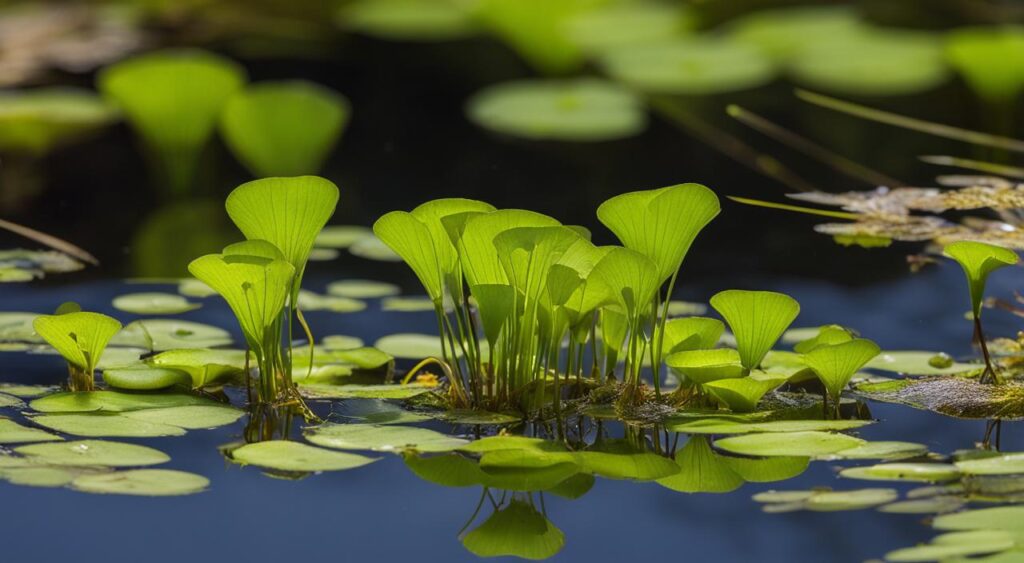
Frogbit (Limnobium laevigatum) is a low-maintenance floating aquarium plant that derives its nutrients from the water column through its roots. Therefore, specific feeding or fertilization is not necessary for this plant. However, if the tank water lacks essential nutrients like nitrogen, phosphorus, or potassium, it may be beneficial to supplement the water with a liquid fertilizer suitable for aquarium plants.
The amount and frequency of feeding will depend on the specific needs of your aquarium and the overall nutrient balance. It is recommended to follow the instructions provided by the fertilizer manufacturer for the proper dosage. Monitoring the growth and health of your frogbit is vital to ensure that it is receiving adequate nutrition.
CO2 Injection
Frogbit (Limnobium laevigatum) is a low-maintenance plant that does not require CO2 injection for healthy growth. Frogbit can thrive naturally without additional carbon dioxide supplementation than high-demanding plants in planted aquariums. The plant obtains carbon dioxide from the surrounding water, which it efficiently processes for photosynthesis.
CO2 injection systems are commonly used to supplement carbon dioxide levels in planted tanks. However, with frogbit being a floating plant, it can absorb CO2 directly from the air, contributing to the natural water filtration process. This makes Frogbit an excellent choice for aquarium enthusiasts who want to maintain a balanced ecosystem without needing CO2 injection equipment.
Aquarists can enjoy the benefits of this beautiful and functional plant by allowing frogbit to absorb carbon dioxide naturally while minimizing the need for additional maintenance and equipment.
Care
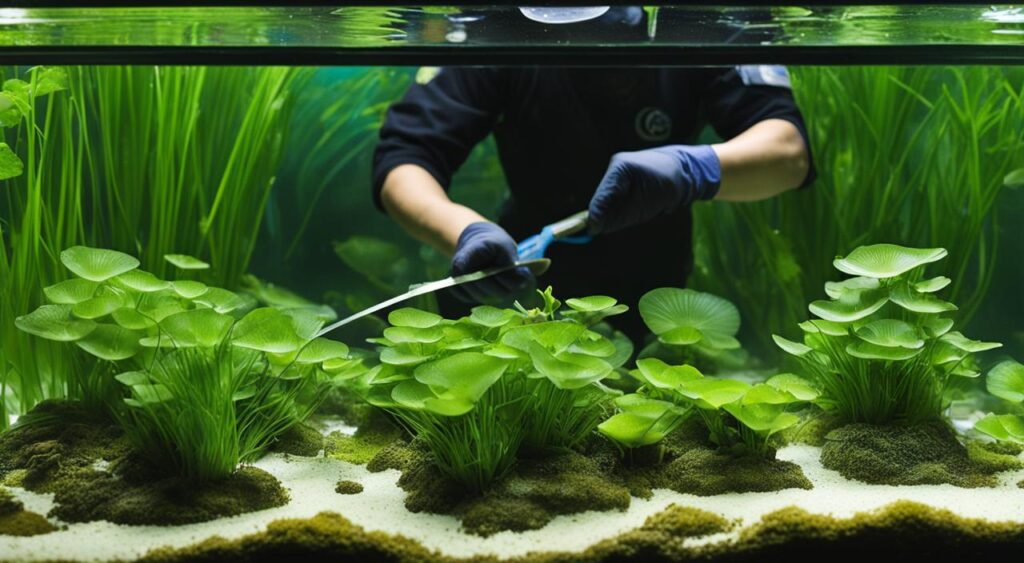
Proper care is essential for the health and well-being of frogbit (Limnobium laevigatum) in a planted tank. To ensure the optimal growth of your freshwater aquarium flora, it is important to consider the following factors:
Planted Tank Parameters
Frogbit thrives in tropical temperatures, with a recommended range of 18-26°C (64-80°F). It is essential to maintain appropriate water parameters to promote the healthy growth of your plants. Frogbit prefers soft to medium water hardness and a pH range of 6.0-7.5. Regular monitoring of water parameters and making necessary adjustments will ensure the ideal environment for your frogbit.
Water Quality
Good water quality is crucial for the well-being of Frogbit. Regular water changes and monitoring ammonia, nitrite, and nitrate levels are necessary to keep the water clean and free from harmful substances. A proper water maintenance routine will help create a healthy and thriving planted tank.
Filtration
Effective filtration is essential for maintaining water clarity and removing excess waste. Consider using filtration systems such as sponge or canister filters to keep the water clean and provide a suitable environment for your frogbit. A well-maintained filter will contribute to your aquatic plants’ overall health and longevity.
Flow
Providing adequate water flow is essential for proper nutrient distribution and preventing stagnant areas in the tank. A gentle flow will help ensure that all areas of the tank receive sufficient nutrients, promoting the healthy growth of your frogbit. Consider adjusting the flow rate of your filtration system or using additional water circulation devices to achieve optimal water movement.
Following these care guidelines will help you maintain a thriving planted tank with a healthy frogbit (Limnobium laevigatum). Paying attention to tank parameters, water quality, filtration, and flow will provide the ideal conditions for your freshwater aquarium flora and contribute to your aquarium’s natural water filtration process.
Aquarium Maintenance
Testing Water Conditions
Regular testing of water conditions is essential for the health and well-being of frogbit (Limnobium laevigatum) and the overall balance of the aquarium ecosystem. It is essential to monitor critical parameters such as temperature, pH, and water hardness to ensure they remain within the optimal ranges for the plant’s growth and vitality.
With a reliable aquarium water test kit, you can quickly assess the water quality and make any necessary adjustments. Regular testing will help you maintain the ideal conditions for Frogbit and create a healthy environment for your aquatic plants and animals.
How To Set Up Your Aquarium Tank
When setting up an aquarium tank for frogbit, providing the right conditions for its growth and development is crucial. Here are some essential steps to follow:
- Choose the right substrate: Select a suitable substrate that supports the growth of aquatic plants. A nutrient-rich substrate will provide the necessary elements for healthy plant growth.
- Install proper lighting: Use appropriate lighting fixtures that emit the correct spectrum and intensity of light for Frogbit’s needs. Ensure that the light reaches all areas of the tank, particularly the water surface where the frogbit will be floating.
- Set up a filtration system: Install an efficient filtration system to maintain water cleanliness and remove any accumulated waste or debris. This will help create a stable and healthy environment for frogbit and other aquatic inhabitants.
- Add frogbit to the tank: Gently place it on the water surface, allowing it to float freely. Avoid submerging the leaves or roots, as this can impede its growth and cause damage.
Propagation Methods
Frogbit can be easily propagated through plantlets that develop on stolon segments. These plantlets can be separated and replanted to create new growth and expand your frogbit population. Here’s how to propagate frogbit:
- Identify healthy plantlets: Look for young plantlets growing from the stolon segments of mature frogbit plants. These plantlets will have small roots and leaves.
- Gently separate the plantlets: Carefully detach them from the main plant by gently pulling them apart. Be mindful not to damage the delicate roots and leaves.
- Plant the separated plantlets in a suitable tank area, ensuring they float freely on the water surface. Provide appropriate light, water, and nutrient conditions to encourage successful growth.
Following proper propagation methods, you can quickly expand your frogbit population and maintain a thriving aquatic ecosystem.
Health And Disease
Monitoring the health of frogbit (Limnobium laevigatum) is important to ensure its well-being and prevent common health issues. Proper care and maintenance are critical to your frogbit thriving in your freshwater aquarium.
Signs Of Good Health
Healthy frogbit displays vibrant green leaves, actively grows, and shows no signs of wilting or browning. Lush and green foliage indicate that the plant receives adequate nutrients and suitable water parameters.
Signs Of Poor Health
Signs of poor health in frogbit include yellowing or browning leaves, slow growth, or wilting. These symptoms may result from improper water parameters, nutrient deficiencies, or exposure to harmful substances.
Common Health Issues And Treatment
Fluctuations in water parameters, such as temperature, pH, and water hardness, can cause common health issues in frogbit. Nutrient deficiencies, particularly nitrogen, phosphorus, and potassium, can also affect the plant’s health. To address these issues, it is crucial to maintain stable water conditions and provide proper nutrition through regular fertilization. Monitor the plant closely and make adjustments as necessary to improve its health and overall well-being.
Plant Pests
Like other plants, frogbit may be susceptible to certain pests, such as snails or algae. These pests can hinder the plant’s growth and affect nutrient uptake. Regular inspection and appropriate pest control methods should be implemented to prevent infestations and maintain the plant’s health. If necessary, you can manually remove pests or use safe treatments for the plant and the aquarium ecosystem.
Summary
Frogbit (Limnobium laevigatum) is a versatile and visually appealing addition to any aquarium or aquascape. It provides shade, refuge, and a natural filtration system for the tank. With its floating nature, frogbit adds beauty to the water’s surface and creates a lush environment for aquatic animals.
Care for frogbit involves maintaining suitable tank parameters, providing adequate lighting, and monitoring the plant’s health. It is crucial to ensure the tank parameters such as water temperature, pH, and hardness are within the recommended ranges. Frogbit thrives in tropical temperatures of 18-26°C (64-80°F) and prefers soft to medium water hardness with a pH range of 6.0-7.5.
Proper lighting is essential for the healthy growth of frogbit. It requires medium to high lighting levels to thrive, but direct, intense lighting should be avoided as it can damage the leaves. Regularly monitoring the plant’s health is vital to identify any signs of poor health, such as yellowing or browning leaves, slow growth, or wilting. Taking timely action and addressing any issues will help maintain the beauty and benefits of frogbit in the aquatic habitat.
In summary, frogbit (Limnobium laevigatum) is a low-maintenance, decorative plant that can enhance the appearance of aquariums or aquascapes. By providing shade, refuge, and natural water filtration, frogbit offers a beneficial environment for aquatic animals. With proper care and maintenance, aquarists can enjoy the beauty and benefits of frogbit in their marine habitats.
FAQ
What is Frogbit (Limnobium laevigatum)?
Frogbit is a floating aquatic plant commonly used in aquariums and aquascapes for its decorative appearance and functional benefits. It has round or circular leaves and long, fuzzy roots.
Where is Frogbit native to?
Frogbit is native to tropical and subtropical Central and South America. It is found in various freshwater habitats, including ponds, bogs, ditches, marshes, and swamps.
How should Frogbit be placed in the aquarium?
Frogbit should be placed as a floating plant on the water surface. It should not be submerged.
What lighting does Frogbit require?
Frogbit requires medium to high lighting levels to thrive. Direct intense lighting should be avoided as it can cause damage to the leaves.
What are good tank mates for Frogbit?
Good tank mates for Frogbit include Guppies, Platys, Mollies, Swordtails, and other livebearers. These fish species appreciate the shade and shelter provided by the floating plant.
Does Frogbit require feeding or fertilization?
Frogbit derives its nutrients from the water column through its roots and does not require specific feeding or fertilization. However, if the tank water lacks essential nutrients, supplementation with a liquid fertilizer may be necessary.
Does Frogbit require CO2 injection?
Frogbit does not require CO2 injection for healthy growth. It can naturally absorb CO2 from the air and contributes to the natural water filtration process.
What care does Frogbit require?
Frogbit requires maintaining suitable tank parameters, providing adequate lighting, and monitoring the plant’s health. Water quality, filtration, and flow should also be considered.
How do you propagate Frogbit?
Frogbit can be propagated through plantlets that develop on stolon segments. These plantlets can be separated and replanted to create new growth.
What are common health issues in Frogbit?
Common health issues in Frogbit can be caused by improper water parameters, nutrient deficiencies, or exposure to harmful substances. Proper monitoring and treatment may be required.
What are the benefits of Frogbit in an aquarium?
Frogbit provides shade, refuge, and natural water filtration in an aquarium. It also adds a visually appealing water surface and creates a lush environment.
Is Frogbit easy to care for?
Frogbit is considered a low-maintenance plant and can adapt to a wide range of water conditions. It is relatively easy to care for in an aquarium setting.

